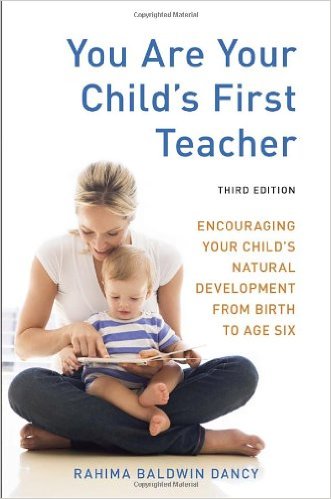You Are Your Child’s First Teacher – A Classic Book Review
The importance of what our children learn in the home and through their relationship with us forms the irreplaceable foundation of all that comes later. Mother, childbirth educator, midwife, and Waldorf educator, Baldwin aims to deepen our understanding of the nature of the young child as a whole being–body, mind, emotions, and spirit–so enabling us to meet their needs for balanced development.
It is Baldwin’s sensitive, sincere, and ever-so-natural tending to the soul and spirit, as well as mind and body, of the newborn and young child, that makes this a very special book.

In a society which values intellectual development above all else, we tend to ignore other aspects of development. We reason with our children as if they were grown ups and teach them with techniques appropriate for much older children. Distrustful of natural processes, we believe we have to do something in order to ensure our child’s development. Milestones of the first three years–walking, talking, thinking, and memory–occur by themselves, according to their own timetable. Trusting natural processes does not mean that we do nothing, but that the things we do need to be consonant with the child’s own developmental stages.
The world of the young is critically endangered, as more and more children are placed in daycare in infancy, and academic pursuits are pushed onto younger and younger children. The hurried child syndrome is apparent in all spheres of activity. We try to speed their development with baby walkers and gymnastics, and reason with five-year-olds as if their ease with words ought to translate into control of their actions in the future. Problems arise when we fail to realize how different a three year old is from a child of nine, or a teen from an adult. Children do not think, reason, feel, or experience the world the way an adult does.
Understanding that incarnation into earthly life is a gradual process, we can clarify how we perceive, interact with, and help our children so they realize their full potential. Recognizing a vertical stream of knowing individuality as well as a horizontal stream of hereditary characteristics in each child, a primary task of parents is to seek to harmonize the two, so that one does not dominate to the exclusion of the other.
Baldwin writes of the passage from womb to world as a very significant and sacred time. The first six weeks of life are a time of tremendous transition between one level of existence and another. The energy of creation that is present is “very powerful and holy,” and more accessible if acknowledged and protected. It is a time for the new mother to practice doing nothing, to just be centered in her heart or in her breath, and a special time to just be together as a family.
The sensitivity of the newborn calls for special regard at birth, and in the months following. Baldwin emphasizes the importance of paying attention to the quality of the infant’s surroundings and the experiences that come to her. For example, protecting the baby from bright lights, focusing on the quality of sounds that reach her ears–in terms of volume, harmony, and rhythm–and offering stimulation from natural rather than artificial sources.
She advocates nurturing babies’ development through the first year by touching, carrying, talking, singing, contact with nature, nursery rhymes, and movement games. She cautions against baby bouncers, baby walkers, playpens, and baby gymnastics, and believes that one of the greatest gifts parents can give a child between birth and first grade is time and materials for the creative play which helps her work her way into earthly life by imitating all she experiences. The very young do not need playgroups (though their parents might!), gymnastics, educational tools, nor fancy toys. They need circle and movement games, songs, musical and artistic activities, and examples of real work for imitation. They need contact with nature, nourishing images from stories, and simple toys they can complete with the imagination. We learn, for example, that the beautiful doll and the anatomically correct doll are a hindrance to the child’s inner development, leaving nothing for her imagination to supply, and providing more than she can hold in awareness. Toys based on TV and movie characters (therefore with fixed personalities) leave little room for creative imagination. Baldwin urges that we consider not only the safety, but aesthetic quality of a toy. Is it beautiful? How does it feel to the touch? What pictures of the world does it offer the child?

She cautions us against providing rational and scientific answers before our children are ready. Because their verbal skills far outweigh their conceptual knowledge, we tend to answer at a level of abstraction far beyond their comprehension. Calling directly on the intellect and memory of the child during the first seven years, not only takes him away from movement and valuable play, but accelerates his change of consciousness and robs him of valuable years of early childhood–years vital to later physical health and mental development. At this age, children learn best through direct life experiences and imitation.
Baldwin describes discipline as a process of effectively and consistently setting limits, and guiding a child to develop in a healthy way physically, emotionally, and mentally, rather than simply correcting undesirable behavior. She emphasizes the importance of imitation and example, patience, repetition, and rhythm.
We are reminded that how a child enters sleep and wakes impacts the spirit as well as the body, and the quality of both sleeping and waking life. Celebrating festivals and the course of the year “is not only important in individuals” lives, but is important socially, and for the possibility it provides us to step out of “ordinary time” and be connected with something more abiding.”
Baldwin addresses a host of basic issues–such as toilet training, separation anxiety, cabin fever, sharing meals, nutrition, naps, quiet times, childcare, breastfeeding, co-sleeping, and educational TV programs for the young (which she does not endorse.) She suggests what to do to encourage the balanced development of the five-year-old who is already reading, and the impacts of divorce, death, and a new sibling. She looks at the Waldorf early-childhood program and Waldorf education in the home. She encourages us to trust our heart, and value our parenting. Not everyone can stay at home in the first three years but she urges that we reject the notion that it’s all the same.
Encouraging us to see our children as unique individuals with their own personalities and lives to live, and parenting as part of our own inner growth, Baldwin writes:
The young child accepts us as perfect and good; once he becomes older and sees our imperfections, the most important thing is that the child sees we are striving to do better. Our desire for inner growth (or our complacency) is perceived by the child and has a very deep impact on him.
This book includes and goes beyond the physicalities of parenting to offer substance for heart and soul to ponder.
Photo Shutterstock/Vasilchenko Nikita


